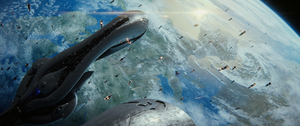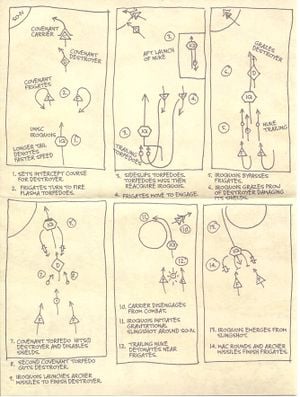Space warfare
From Halopedia, the Halo wiki
| This article does not have enough inline citations and/or does not adhere to the proper citation format. You can help Halopedia by adding citations. |

Space warfare is the conduct of conflict between belligerents in space. The scale of space warfare ranges from exoatmospheric fighter skirmishes and boarding actions to battles between fleets of warships, which often decide the outcome of a given engagement or conflict.
History
Space warfare evolved from engagements on a world's surface or in its atmosphere. With the invention of human space travel in the 20th century, many organizations and nations began to consider or invest in possible military operations conducted in space. In the late 21st century, humanity had become an interplanetary-faring species with colonies established in their home system. The new outlet of travel and exploration would eventually lead to conflict.[1] The dawn of the Interplanetary War and its associated engagements saw the formation of the United Nations Space Command's Navy following the Mars Campaign. The campaign marked a turning-point in space warfare through dedicated utilizations of UNSC Marine Corps forces in ground assaults and ship-boarding operations that would follow during the war.[2]
In the late 23rd century, humanity invented and began to utilize the Shaw-Fujikawa Translight Engine on their spacecraft, allowing human ships to travel through slipstream space to reach destinations light-years away.[3] The UNSC Navy only conducted low-level operations, such as anti-piracy actions, until the Insurrection, which forced the Navy to develop a modern space warfare doctrine. Following the Callisto Incident of 2494, the numerous small-scale space engagements occurred between the UNSC Navy and Insurrectionists across human space.[4]
 This section needs expansion. You can help Halopedia by expanding it.
This section needs expansion. You can help Halopedia by expanding it.
The Covenant races, meanwhile, have been spacefaring for significantly longer than humanity. The Sangheili are known to have become a spacefaring civilization prior to 938 BCE, when they encountered the San'Shyuum. The resulting conflict was fought on both planetary surfaces and in space engagements, where the San'Shyuum held the distinct advantage due to their use of the Forerunner Dreadnought, a Forerunner keyship fitted by the San'Shyuum with offensive armament. In 1342, the Covenant fought the many Kig-Yar pirate and militia groups around Eayn, including naval engagements against space-based raiders in their homeworld's asteroid belt, where their smaller ships and intimate knowledge of their environment benefited the Kig-Yar until they agreed to be employed by the Covenant. Covenant warships also took part in the glassing of Balaho during the Unggoy Rebellion, though likely faced little serious naval opposition.
Technology
- Main articles: UNSC Navy, Covenant fleet, Forerunner fleet
As with warfare in general, the level of a given polity's technological advancement plays a considerable role in space engagements, and a technological edge can easily overcome superior tactics once the technological gap is substantial enough. During the Human-Covenant War, UNSC warships and weapon systems were decidedly inferior to their Covenant counterparts. This has changed in the post-war era with the introduction of new, more advanced technologies to UNSC Navy service as well as the Covenant's reduction into various smaller splinter groups with lessened access to the bleeding edge of Covenant technology.[5]
Weaponry
Human starship weapons follow a similar trend as their ground armament and are largely based around ballistic impacts and chemical reactions. Meanwhile, Covenant weapons employ magnetically superheated plasma in their various weapon systems, a major contributor to their significant edge over the UNSC during the Human-Covenant War.
Human starship weapons are, for the most part, projectile-based, consisting of guided missiles with variable conventional or nuclear warhead yields or magnetically accelerated unguided projectiles. In combat, UNSC warships employ Magnetic Accelerator Cannons as their primary armaments, powerful coilguns built into the superstructure of the ship capable of accelerating a ferric tungsten shell to a significant fraction of the speed of light, supported by a range of missile types, from smaller-yield ship-to-ship Archer, Rapier and Howler missiles to more powerful nuclear Hyperion, Rudra, FENRIS, HAVOK or Shiva missiles. UNSC naval strategy emphasizes massed firepower to overwhelm the Covenant's powerful defences - typically an initial missile salvo to penetrate Covenant point defence, followed up with a timed MAC strike against the vulnerable ship. Single MAC strikes by even smaller UNSC warships are able of crippling or destroying an unshielded Covenant vessel. The velocity of a MAC round can be adjusted to deliver ordnance from orbit against planetary targets, though the still-powerful kinetic energy they impart on impact means their use is limited. UNSC prowlers are the only known UNSC warship class to use pulse laser turrets, though as stealth ships their primary offensive role is their ability to lay HORNET space mines.
The Covenant, on the other hand, employ more arcane weaponry derived from even more advanced Forerunner technology. The typical offensive armament for a Covenant warship consists of plasma torpedo turrets and energy projectors to engage enemy combatants. Plasma torpedoes are a form of superheated plasma contained and shaped by a magnetic field and guided to the target. While the magnetic field has been created by the ship, plasma torpedoes have been known to continue tracking their targets after the destruction of the warship that launched them. A single plasma torpedo is capable of burning through UNSC hull plating and even through several deck layers in one hit. Energy projectors are powerful particle accelerators, akin to a larger focus rifle, typically used as long-range armaments. They have been known to cut through even UNSC carriers with little difficulty, but require more power to operate, especially on warships with more than one energy projector. Both of these weapons systems can be used by the Covenant to bombard planetary positions from orbit, in a process known as glassing.
Defenses
UNSC warships use various forms of Titanium-A armor (an enhanced form of titanium) as their exterior battleplate. Covenant vessels are covered in nanolaminate hull plating, which is significantly stronger and more resilient. Most Covenant ships are also protected by energy shielding, which has seen limited adoption among UNSC Navy warships—including the Strident-class heavy frigates—in the post-war era.[5] Both sides also make use of point defence weapons, designed to target and destroy singleships and missiles. UNSC ships use a number of different railgun point defence systems, while Covenant point defence is usually performed by more advanced pulse laser turrets.
Both the UNSC and the Covenant are known to use dedicated space stations to defend their worlds. UNSC orbital defense platforms are anchored to a geosynchronous orbit and are armed with a powerful "super" MAC gun powered by a groundside generators. Covenant equivalents use versions of the energy projectors used on their warships.[6][7]
 This section needs expansion. You can help Halopedia by expanding it.
This section needs expansion. You can help Halopedia by expanding it.
Singleships
Ship classes
Capital ships
 This section needs expansion. You can help Halopedia by expanding it.
This section needs expansion. You can help Halopedia by expanding it.
Single ships
While naval combat is the purview of capital ships, smaller craft are used by the UNSC Navy and Covenant fleet in a number of roles. The most common human starfighter, the GA-TL1 Longsword, is able to perform a wide range of combat operations including escort, minelaying, spacefighter interdiction and direct action against even capital ships, using a range of variable armaments. The smaller F-41 Broadsword is similarly capable of performing a number of mission roles. The advanced YSS-1000 Sabre fighter saw use during the Fall of Reach and is still employed in more limited numbers by the Office of Naval Intelligence to protect classified sites, but pioneered the use of energy shielding on human spacecraft, which was later adopted by modernized Broadswords. Both use a combination of 30mm and 35mm autocannons (respectively) and ST/Medusa missile payloads to engage enemy forces. During boarding operations, UNSC forces use specialized Pelican dropship variants to cut through the outer hull of a ship and deploy forces within to secure it.
The Covenant main spacefighter is the Type-27 Banshee fighter, used in a similar role to the Longsword in escort, interdiction and direct action engagements in large numbers, usually in tandem with the more durable Type-31 Seraph. The Covenant use specialized Phantom gunboats to deliver heavy ordinance in direct action against capital ships and to support Seraph and Banshee squadrons in an anti-fighter role, and smaller Type-44 and Type-52 Phantom dropships and other boarding craft to deliver boarding teams to secure hostile ships or space stations.
Battle doctrine
The conduct of space warfare varies significantly between the Forerunners' height and modern times due to the impact of the more advanced technologies employed in the former era in both strategic and tactical contexts. In addition, both the Covenant and UNSC fleets emphasise different strategies and tactics governed by technological capability.
Forerunner era
Space engagements carried out by Forerunners and their technologically equivalent contemporaries—most prominently ancient humans—were dazzlingly complex yet controlled affairs, involving seamless coordination across large distances as well as weapon systems and defenses extending through higher space-time branes.[8] These battles unfolded at speeds impossible for baseline individuals to follow[9] and often involved copious numbers of often automated attack craft, with each maneuver adjusted to fit the current tactical situation according to constantly shifting predictive calculations;[8] biological commanders could effectively contribute to these engagements due to sophisticated neurocognitive enhancement and mind-machine integration, enabling them to simultaneously perceive numerous differing viewpoints.[9][10] Individual Warriors would typically command up to a million weapon-ships during fleet engagements,[11] while the numbers of attack ships such as harriers could easily be in the hundreds of thousands.[8] In addition to physical weaponry, opposing ships also deployed weaponized AI systems and confinement fields against one another with the intent of eliminating the enemy vessel's capacity for resistance.[12] Higher-level combat skins such as war sphinxes blurred the line between infantry, aerial attack craft and space fighters and were used to a great effect in battles waged over planets.[13]
 This section needs expansion. You can help Halopedia by expanding it.
This section needs expansion. You can help Halopedia by expanding it.
Modern era
In the modern era, space battles are fought almost exclusively within the context of normal space-time, although precision slipspace jumps and faster velocities within the slipstream offer increased tactical maneuvering options as well as considerable strategic benefits. The vessels involved are typically directed by individuals with baseline reflexes delivering tactical commands verbally, placing certain upper limits on the speeds at which ships and fleets can respond to threats and changing tactical situations; under the control of an AI, a warship becomes far more combat-effective due to the constructs' significantly faster reactions and information processing capabilities.[14]
Naval engagements have typically been one-sided affairs. During the Human-Covenant War, the Covenant possessed an overwhelming technological advantage, with superior weaponry, defenses and slipspace navigation. In large-scale engagements, the UNSC has been forced to rely on overwhelming numerical superiority just to fight the Covenant to a standstill, and an advantage of five-to-one is the general rule to ensure a UNSC victory. Human fleets have also been forced to rely on innovative use of strategy and tactics to counter Covenant naval doctrine, which has largely remained unchanged throughout the war, which can result in surprising UNSC victories. During the Battle of Sigma Octanus IV, Captain Jacob Keyes' use of a complicated and risky maneuver allowed a single UNSC destroyer to defeat two frigates and a destroyer, forcing the unsupported DDS-class carrier to withdraw after deploying ground forces. In the second large-scale engagement, the UNSC massed its fire for a coordinated MAC salvo, using a repair station as cover against the Covenant's plasma torpedoes to buy time for a second, devastating salvo, reducing the Covenant fleet from twenty ships to eight, allowing the forty eight UNSC ships to engage the enemy in a clear advantage, a tactic repeated on a larger scale during the Fall of Reach. During the Battle of Onyx, Battlegroup Stalingrad used innovative tactics to destroy a disproportionate number of Covenant warships. After using intelligence gathered by the prowler UNSC Dusk to destroy a destroyer, the battlegroup encountered a much larger force attempting to ambush them. Faced with a plasma torpedo salvo, the fleet accelerated into it to forestall a second volley, allowing five ships to survive to withdraw, with a number of enemy ships destroyed by the self-destruction of the UNSC Iwo Jima, taking two warships with it and damaging another six. Exploiting the distraction provided by Onyx's Sentinel forces engaging the Covenant, the Dusk laid a HORNET minefield. The battlegroup lured the Covenant fleet into the field, destroying all but two before Covenant reinforcements arrived, destroying all UNSC ships except for Dusk. In all, Battlegroup Stalingrad, consisting of one carrier, one Marathon-class cruiser, six destroyers and a prowler managed to destroy a total of twenty Covenant warships, a staggering number.
In general, the Covenant employ straightforward strategy and tactics. More complicated manoeuvres are generally unnecessary given the Covenant's overwhelming edge in most engagements, and Covenant ship captains have been known to destroy their ships rather than surrender or retreat. This is not a hard rule, however. The withdrawal of the carrier over Sigma Octanus was remarked upon as unusual, and the Covenant used a number of innovative tactics during the Fall of Reach, managing to insert a cloaked CSO-class supercarrier past Reach's defenses to surreptitiously land ground forces and heavy corvette support in its search for Forerunner artifacts in advance of the main Covenant fleet. Then-Supreme Commander Thel 'Vadamee was considered by the Office of Naval Intelligence as the Covenant's best strategic asset, resulting in the loss of at least seven colonies and more than a billion casualties, and was marked for assassination before the end of the war concluded hostilities.
In the post-war galaxy, humanity's adoption of accurate slipspace drives and energy shields have considerably improved their capabilities against warships employed by Covenant remnant factions. Notably, the UNSC Infinity intervened to support Thel 'Vadam during the Sangheili Civil War, effortlessly destroying a number of ships loyal to the Servants of the Abiding Truth. During the New Phoenix Incident, the UNSC fleet engaged the Forerunner warship Mantle's Approach and the Infinity used its MAC weapons to create a hole in the ship's hull large enough for the Master Chief to pilot a Broadsword fighter deep into it. During the Second Battle of Requiem, Infinity collided with an RCS-class armored cruiser, plowing through it with no hull damage and shields intact. It should be noted that the Infinity is the UNSC's most advanced current starship, and uses Forerunner technology to power its systems, and is likely not representative of overall UNSC naval capabilities.
 This section needs expansion. You can help Halopedia by expanding it.
This section needs expansion. You can help Halopedia by expanding it.
List of appearances
Sources
- ^ Halo Encyclopedia, page 266 (2011 edition)
- ^ Xbox.com/Halo
- ^ Halo Encyclopedia, page 43 (2011 edition)
- ^ Halo: Evolutions, "The Impossible Life and the Possible Death of Preston J. Cole"
- ^ a b Halo 4: The Essential Visual Guide, page 192
- ^ Halo: Escalation, Issue #6
- ^ Halo Waypoint: Catalog Interaction (post 2994218)
- ^ a b c Halo: Silentium, pages 211-212
- ^ a b Halo: Cryptum, pages 161-162
- ^ Halo: Cryptum, page 316
- ^ Halo: Cryptum, page 174
- ^ Halo: Cryptum, pages 193-194
- ^ Halo: Cryptum, pages 66, 95, 163
- ^ Bungie.net: Jason Jones Interviewed By You (12/18/2001)

